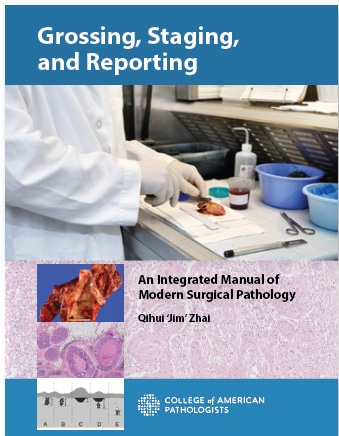July 2021—CAP Publications released this month Grossing, Staging, and Reporting—An Integrated Manual of Modern Surgical Pathology, edited by Qihui “Jim” Zhai, MD, professor of laboratory medicine and pathology, consultant pathologist, and director of the FISH laboratory, Mayo Clinic Florida. The manual consists of 12 sections—from breast to thorax—and 54 chapters, organized by organ.
CAP TODAY asked Dr. Zhai to tell us about the new book. Our questions and his answers follow. A sample chapter follows this article.
You write in the preface that the book is the first to cover grossing, staging, and reporting within a single manual. Is this gap of sorts the reason you proposed and created this book, or was there a different or another reason? In short, why this book and why now?
All three major surgical pathology components—grossing, staging, and reporting—are closely connected in our practice. Specimen handling and grossing is the first and fundamental step. Accurate staging requires appropriate sampling of the specimen, and it is essential to keep the necessary staging information in mind before dissecting the specimen. Our ultimate goal is to produce a comprehensive yet succinct pathology report that is a medical and legal document for the patient’s subsequent care. That is why I feel it is critical to cover these three components in one book in an integrated fashion.

Dr. Zhai
The idea to put together such a manual has been with me for a while, from my training to practice in different settings, with various inspirations. The format and content have been evolving. A couple of years ago I felt it was time to start this project. The CAP has been working to promote standard practice among pathologists, and this book is an example of a resource that can help achieve that.
During my residency at Mayo Clinic in Rochester, residents participated in a monthly gross conference with microscopic correlation called the “MBD,” so named for Dr. Malcolm B. Dockerty, a pioneer pathologist at Mayo Clinic. This conference was taught by the legendary Dr. Krishnan Unni and began with a gross photo for which every resident was called to offer a diagnosis. Once all the residents had given their opinions, the corresponding microscopic images would be correlated and a diagnosis rendered. This conference was both stressful and fun for a junior resident. Nowadays, I benefit a great deal from the macroscopic diagnostic skills I gained from this conference, as I still evaluate gross specimens and advise where to sample during frozen sections and difficult cases.
After residency, in an oncologic surgical pathology fellowship at MD Anderson Cancer Center, I grossed many complex specimens, which enabled me to continue learning and improving upon the skill set acquired during residency. Raymond’s Paragraph System, a gross pathology report formatting system used to describe a particular specimen for most organ systems, was introduced by Dr. Kevin Raymond and then applied at Houston Methodist Hospital. Annette Dayton, an outstanding pathologists’ assistant, along with Drs. Alberto Ayala, Jae Ro, and Mary Schwartz and Dr. Raymond, summarized their experience and wrote a manuscript, “Raymond’s Paragraph System: An Alternative Format for the Organization of Gross Pathology Reports and Its Implementation in an Academic Teaching Hospital,” published in Archives of Pathology & Laboratory Medicine [Dayton AS, et al. Arch Pathol Lab Med. 2009;133[2]:298–302].
Training and practicing in different settings granted me the opportunity to read pathology reports from all over the world. The styles and approaches to gross pathology vary drastically. Sometimes it can be difficult to mentally reconstruct the specimen based on the original gross description, which may make it impossible to evaluate and stage the tumor accurately.
The importance of consistency and standard approaches to handling the specimen, staging the tumor accurately, and reporting comprehensively but succinctly cannot be overemphasized. The quality of our pathology practice directly determines the safety and quality of the patient’s care.
CAP president Patrick Godbey, MD, writes in his foreword that the authors have been creative in their approach to presenting the traditional skills of grossing and staging and incorporating molecular knowledge. Can you provide more detail about that and generally tell us about the book’s content?
Molecular and genomic tools have become vital in modern pathology and have empowered us to resolve many mysteries of the past. In particular, biomarkers have allowed us to more accurately classify tumors, offer therapeutic choices, and predict prognosis. Validation of these powerful tools depends heavily on reliable clinical staging information. Therefore, the traditional grossing, staging, and reporting skills will serve an even more vital role as the foundation for future individualized regimens for cancer patients.
In this manual, the authors emphasize the traditional skills used in our daily surgical pathology practice and include pertinent molecular knowledge that has become standard in modern surgical pathology. We need to first make sure our diagnosis is correct in order to use the appropriate staging template. An example is the spindle cell proliferation in the gastrointestinal tract. Molecular knowledge is critical now to the process of diagnosing a gastrointestinal stromal tumor, or GIST. New molecular and genetic tools are fascinating and have resulted in many new diagnostic and therapeutic biomarkers that improve patient care. However, the significance and accuracy of molecular findings depend heavily on consistent and accurate staging and clinical validation. It is this integration of the traditional skills—grossing, staging, and reporting—with the evolving molecular techniques that will allow us to offer standardized and individualized therapeutic regimens to patients with complex diseases.
What can you tell us about the book’s more than 40 authors who contributed?
It is an honor and one of the highlights of my career and of my life to have worked on this project and to have collaborated with some of the most dedicated and talented pathology colleagues from various practice settings. We invited extremely experienced practicing pathologists to contribute, and many participated in the CAP cancer templates workgroups and contributed to the AJCC Cancer Staging Manual. They represent the collective wisdom of their premier institutions. The styles in the manual will vary slightly here and there, but the focus is always on the critical information and essential points. We do not mean that what we have provided in this book is the only correct way to apply the information in each practice setting. It is our collective goal that pathologists, trainees, and pathologists’ assistants will find this manual a valuable resource for grossing, staging, and reporting.
Was there any particular challenge to covering all three surgical pathology components in one book?
To cover three major components of surgical pathology within one book is challenging because there is a lot of material to discuss. We wanted to be comprehensive yet succinct. One of the most efficient ways is to be consistent in the formatting of the chapters. Therefore, we adapted Raymond’s Paragraph System to be more standard, more consistent, and more effective. We provide samples of the paragraph system to describe the macroscopic pathology, a step-by-step illustration of dissection skills, and samples of reports containing necessary information.
We should be cognizant of the economy of the laboratory and practice. Sampling and processing sufficient blocks, while not oversampling, is essential for subsequent staging information. This book will be a resource for helping to improve consistency, efficiency, and safety while shortening turnaround time.
What one or two things about the book do you most want potential readers to know?
First, with more and more amazing technologies emerging and being validated and applied in daily practice, a vast portion of our attention is turning to these new tools, but traditional pathology skills should not be ignored or overlooked. Our daily and routine pathology reports are still the cornerstones of modern medicine.
Second, the hope is that the standard approach in grossing, staging, and reporting will enhance the consistency in reports from different institutions. If so, it will facilitate communication among pathologists, including the consultative services for second opinions and transfer of care. Our paramount goal is to improve our quality of pathology practice and ultimately the quality of patient care.
Here, from the newly released Grossing, Staging, and Reporting—An Integrated Manual of Modern Surgical Pathology, is the chapter on parathyroid, by Sylvia L. Asa, MD, PhD, of University Hospitals Cleveland Medical Center and University Health Network, Toronto, and Case Western Reserve University.
To order (PUB131), call 800-323-4040 option 1 or go to www.cap.org (Shop tab) ($76 for members, $95 for others). For the ebook ($72), go to ebooks.cap.org. If you are interested in writing a book, contact Caryn Tursky at ctursky@cap.org.
Parathyroid
Sylvia L. Asa, MD, PhD
 Parathyroid resection specimens include biopsies, single-gland resections, resections of a large gland with biopsy of a second gland, or resections of three glands with biopsy of a fourth gland. Some procedures include resection of the central compartment of the neck and thymus that may contain ectopic parathyroid tissue.
Parathyroid resection specimens include biopsies, single-gland resections, resections of a large gland with biopsy of a second gland, or resections of three glands with biopsy of a fourth gland. Some procedures include resection of the central compartment of the neck and thymus that may contain ectopic parathyroid tissue.
Pathologic examination is the gold standard for diagnosis and management of patients with hyperparathyroidism. The outcomes of pathology examination offer critical information for the prognosis, therapeutic choices, and future care of the patient. The importance of intraoperative parathyroid hormone measurement has become more widely recognized in recent years,1 and this technology has altered the approach to parathyroid surgery and the role of frozen section for intraoperative consultation. Confirmation of a significant drop in the circulating parathyroid hormone level provides strong evidence of resection of the offending lesion, thereby allowing the surgeon to stop the parathyroidectomy procedure, leaving the rest of the neck intact. In the event of a need for repeat surgery, there is no fibrosis that would interfere with the ability to identify remaining parathyroids.
Appropriate handling of the specimen is an important first step and serves as the foundation for the diagnostic process. The pathology report is not only a medical, but also a legal document for future therapeutic protocols. Pitfalls exist when difficult situations are encountered. We will discuss in detail appropriate specimen handling, macroscopic and microscopic evaluation, and the pertinent information to include in the pathology report.
I. Indications for parathyroid resections
Parathyroid biopsy is the most common parathyroid specimen because it is performed during thyroid surgery. The goal of this procedure is usually to confirm that the surgeon has identified a parathyroid gland to spare during thyroidectomy; the goal is to prevent iatrogenic hypoparathyroidism. Parathyroid biopsy is also performed during parathyroidectomy to confirm the identification of nonlesional glands.
 CAP TODAY Pathology/Laboratory Medicine/Laboratory Management
CAP TODAY Pathology/Laboratory Medicine/Laboratory Management
